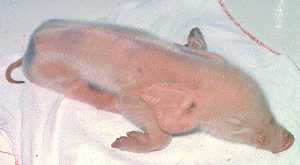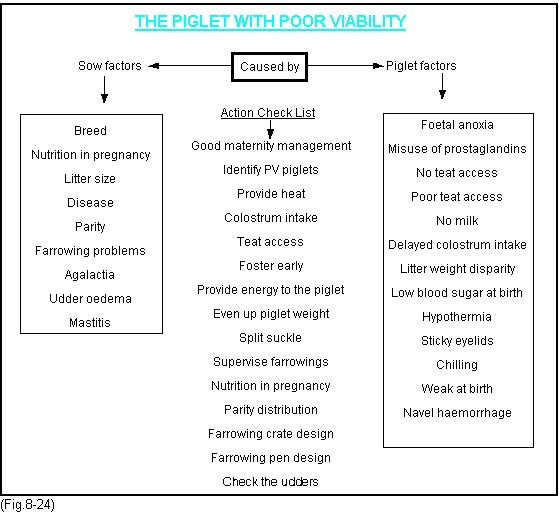



Hypoglycaemia (low blood sugar)
Background and history
Hypoglycaemia is the term for low blood sugar level. During the first few days of life the newborn piglet is unable to mobilise the low glycogen reserves in the liver to provide adequate levels of glucose in the blood. It is therefore dependent for energy on a regular intake of lactose from the sows milk. If a piglet cannot obtain sufficient lactose to maintain its energy output, it runs out of energy, its body temperature drops and ultimately it goes into a coma and dies.
Hypoglycaemia usually occurs in the first 12-24 hours of birth.
Clinical signs
Sows, weaners and growers
- N/A
Piglets
 Piglet with Hypoglycaemia |
- Laid on belly.
- Shivering.
- Becoming very cold.
- Starvation.
- Paddling.
- Fits and convulsions.
- Frothing at the mouth - salivation.
- Comatosed.
- Eyes are sunken and the head bent backwards due to dehydration.
- High mortality.
Diagnosis
This is based on the clinical signs. Examine the eyes to see that there is no evidence of rapid back and fore lateral movements which would indicate meningitis not hypoglycaemia.
Causes
- Low level of sugar in the blood.
- No milk - starvation.
- Severe chilling.
- Wet pens.
- Low viable piglets.
Diseases associated with hypoglycaemia
The following diseases can give rise to hypoglycaemia in piglets.
- Clostridial diseases.
- Congenital tremor.
- Diahorrhoea - acute e.coli infections.
- Low birth rate / poor maturity.
- Mastitis, no milk, no colostrum.
- Navel bleeding.
- Porcine reproductive and respiratory syndrome (PRRS).
- Pseudorabies / Aujesky's disease.
- Splay leg.
- Transmissible gastroenteritis (TGE).
Prevention
- Identify potential piglets at birth and treat as describe under Poor viable piglets in the Stillborn Piglets section.
- The following table provides a background to piglets with poor viability:
Treatment
- The condition must be recognised early if treatment is to be successful.
- Immediately remove the piglet to a warm draught free environment to achieve 30ºC. A box well bedded in shavings with an infra-red lamp above is ideal.
- Feed the piglet with sow, or alternatively cow, colostrum or 20% dextrose solution by syringe or stomach tube every 20 minutes until it has returned to normal. Then introduce the piglet to a newly farrowed sow.








